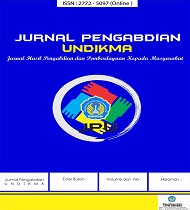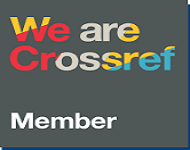Development of The STAD Cooperative Learning Model : Enhancing Mathematical Reasoning and Communication Skills in Higher Education
DOI:
https://doi.org/10.33394/jk.v10i1.10784Keywords:
Mathematics Learning, Reasoning, Communication, STAD Model.Abstract
References
Abdullah, A. H., Julius, E., Ting, Y. Y., Mokhtar, M., & Abd Rahman, S. N. S. (2018). Using cooperative learning to overcome students’ misconceptions about fractions. NeuroQuantology, 16(11), 79. http://doi:10.14704/nq.2018.16.11.1699
Ardiyani, S. M., Gunarhadi, & Riyadi. (2018). Realistic Mathematics Education in Cooperative Learning Viewed from Learning Activity. Journal on Mathematics Education, 9(2), 301-310. https://doi.org/10.22342/jme.9.2.5392.301-310
Astuty, E. S. W., Waluya, S. B., & Sugianto, S. (2019). Mathematical Reasoning Ability Based on Self Regulated Learning by Using The Learning of Reciprocal Teaching With RME Approach. Unnes Journal of Mathematics Education Research, 8(1).
Benavides-Varela, S., Callegher, C. Z., Fagiolini, B., Leo, I., Altoe, G., & Lucangeli, D. (2020). Effectiveness of digital-based interventions for children with mathematical learning difficulties: A meta-analysis. Computers & Education, 157, 103953-103953. https://doi.org/10.1016/j.compedu.2020.103953
Besar, P. H. S. N. b. P. H. (2018). Situated learning theory: The key to effective classroom teaching? HONAI: International Journal for Educational, Social, Political & Cultural Studies, 1(1), 49-60. https:// www.researchgate.net/publication/327530821
Cervantes-Barraza, J. A., & Cabañas-Sánchez, M. G. (2022). Argumentación matemática basada en refutaciones. REDIMAT –Journal of Research in Mathematics Education,11(2), 159-179. https://doi.org/10.17583/redimat.4015To
Dewi, S., Maimunah, M., & Roza, Y. (2021). Analisis Kemampuan Komunikasi Matematis Siswa pada Materi Lingkaran ditinjau dari Perbedaan Gender. Jurnal Kependidikan: Jurnal Hasil Penelitian dan Kajian Kepustakaan di Bidang Pendidikan, Pengajaran dan Pembelajaran, 7(3), 699-707. https://doi.org/10.33394/jk.v7i3.3687
Gunhan, B. C. (2014). A case study on the investigation of reasoning skills in geometry. South African Journal of Education, 34(2), 1-19. https://hdl.handle.net/10520/EJC153699
Hasanah, S. I., Tafrilyanto, C. F., & Aini, A. (2019). Mathematical reasoning: The characteristics of students’ mathematical abilities in problem solving. Journal of Physics: Conference Series, 1188, 012057. https://doi.org/10.1088/1742-6596/1188/ 1/012057
Hayati Dina, Z., & Ikhsan, M. (2019). The Improvement of Communication and Mathematical Disposition Abilities through Discovery Learning Model in Junior High School. Journal of Research and Advances in Mathematics Education, 4(1), 11-22.
Hidayat, W., Rohaeti, E. E., Ginanjar, A., & Putri, R. I. I. (2022). An ePub Learning Module and Students' Mathematical Reasoning Ability: A Development Study. Journal on Mathematics Education, 13(1), 103-118. http://doi.org/10.22342/jme.v13i1.pp103-118
Isnaeni, S., Fajriyah, L., Risky, E. S., Purwasih, R., & Hidayat, W. (2018). Analisis kemampuan penalaran matematis dan kemandirian belajar siswa SMP pada materi persamaan garis lurus. Journal of Medives: Journal of Mathematics Education IKIP Veteran Semarang, 2(1), 107-116. https://doi.org/10.31331/medives.v2i1.528
Jensen, E. O., & Skott, C. K. (2022). How can the use of digital games in mathematics education promote students’ mathematical reasoning? a qualitative systematic review. Digital Experiences in Mathematics Education, 8(2), 183-212. https://doi.org/10.1007/s40751-022-00100-7
Kadioglu, M., Tacgin, Z., & Sahin, N. (2020). Instructional design and material development progress to elearning environments: A sample of obstetrical nursing education. Contemporary Educational Technology, 12(1), ep265. https://doi.org/10.30935/cedtech/7631
Khainingsih, F. G., Maimunah, M., & Roza, Y. (2020). Analisis Kemampuan Penalaran Matematis Siswa SMP dalam Menyelesaikan Soal Open-Ended pada Materi Teorema Pythagoras. Jurnal Kependidikan: Jurnal Hasil Penelitian Dan Kajian Kepustakaan Di Bidang Pendidikan, Pengajaran Dan Pembelajaran, 6(2), 266-274. https://doi.org/10.33394/jk.v6i2.2566
Khan GN, Inamullah HM. Effect of student’s team achievement division (STAD) on academic achievement of students. Asian Social Science 2011; 7(12): 211.
Kim, D. (2018). A study on the influence of Korean middle school students' relationship through science class applying STAD cooperative learning. Journal of technology and Science Education, 8(4), 291-309. https://doi.org/10.3926/jotse.407
Klingenberg, O. G., Holkesvik, A. H., & Augestad, L. B. (2020). Digital learning in mathematics for students with severe visual impairment: a systematic review. British Journal of Visual Impairment, 38(1), 38-57. https://doi.org/10.1177/0264619619876975
Lee, J. (2015). “Oh, I just had it in my headâ€: Promoting mathematical communications in early childhood. Contemporary Issues in Early Childhood, 16(3), 284-287. https://doi.org/10.1177/1463949115600054
Li, F.-Y., Hwang, G.-J., Chen, P.-Y., & Lin, Y.-J. (2021). Effects of a concept mapping-based two-tier test strategy on students’ digital game-based learning performances and behavioral patterns Computers & Education, 173, 104293-104293. https://doi.org/10.1016/j.compedu.2021.104293
Mayer, R.E. (1999). The Promise of Educational Psychology vol II: Teaching for Meaningful Learning. USA: Merill Prentice Hall
Mukuka, A., Mutarutinya, V., & Balimuttajjo, S. (2021). Mediating Effect of Self-Efficacy on the Relationship between Instruction and Students’ Mathematical Reasoning. Journal on Mathematics Education, 12(1), 73-92. http://doi.org/10.22342/jme.12.1.12508.73-92
Muthmainnah, S. N., & Marsigit, M. (2018). Gaya mengajar guru pemula dan guru profesional dalam pembelajaran matematika sekolah menengah pertama. Jurnal Pendidikan Dan Kebudayaan, 3(2), 202-216. https://doi.org/10.24832/jpnk.v3i2.896
Narzoles DG. Student Team Achievement Division (STAD): Its effect on the Academic performance of EFL Learners. American Research Journal of English and Literature.(1). 2015; 1.
Norqvist, M., Lithner, J., Jonsson, B., & Liljekvist, Y. (2015, February). Creative reasoning more beneficial for cognitively weaker students. In CERME 9-Ninth Congress of the European Society for Research in Mathematics Education (pp. 502-503).
Otoo, D., Iddrisu, W. A., Kessie, J. A., & Larbi, E. (2018). Structural model of students’ interest and self-motivation to learning mathematics. Education Research International, 2018, 1-10. https://doi.org/10.1155/2018/9417109
Pahrudin, A., Ahid, N., Huda, S., Ardianti, N., Putra, F. G., Anggoro, B. S., & Joemsittiprasert, W. (2020). The effects of the ECIRR learning model on mathematical reasoning ability in the curriculum perspective 2013: Integration on student learning motivation. European Journal of Educational Research, 9(2), 675-684. https://doi.org/10.12973/eu-jer.9.2.675
Palinussa, Anderson Leonardo, Juliana Selvina Molle, and Magy Gaspersz. "Realistic Mathematics Education: Mathematical Reasoning and Communication Skills in Rural Contexts." International Journal of Evaluation and Research in Education 10.2 (2021): 522-534. DOI: 10.11591/ijere.v10i2.20640
Peraturan Menteri Pendidikan Nasional Nomor 22 Tahun 2006 tentang Standar Isi untuk Satuan Pendidikan Dasar dan Menengah.
Pourdavood, R. G., & Wachira, P. (2015). Importance of mathematical communication and discourse in secondary classrooms. Global Journal of Science Frontier Research, 15(10), 9-20. https://globaljournals.org/GJSFR_Volume15/2-Importance-of-Mathematical.pdf
Ramadhani, R., Rofiqul, U., Abdurrahman, A., & Syazali, M. (2019). The effect of flipped-problem based learning model integrated with LMS-google classroom for senior high school students. Journal for the Education of Gifted Young Scientists, 7(2), 137-158. https://doi.org/10.17478/jegys.548350
Rohid, N., & Rusmawati, R. D. (2019). Students' Mathematical Communication Skills (MCS) in Solving Mathematics Problems: A Case in Indonesian Context. Anatolian Journal of Education, 4(2), 19-30. https://doi.org/10.29333/aje.2019.423a
Sa'adiah, H., Syaiful, S., Hariyadi, B., & Yudistira, P. (2021). Student team achievement divisions (STAD) and jigsaw learning in terms of numerical abilities: The effect on students' mathematics learning outcomes. Desimal: Jurnal Matematika, 4(3), 247-260.
Seepiwsiw, K., & Seehamongkon, Y. (2023). The Development of Mathematical Problem-Solving and Reasoning Abilities of Sixth Graders by Organizing Learning Activities Using Open Approach. Journal of Education and Learning, 12(4), 42-49. https://doi.org/10.5539/jel.v12n4p42
Serdyukov, P. (2017). Innovation in education: what works, what doesn’t, and what to do about it?. Journal of research in innovative teaching & learning, 10(1), 4-33. https://doi.org/10.1108/JRIT-10-2016-0007
Sirait, R. W., Sirait, S. H. K., & Jeni, J. (2024). The Implementation of STAD learning model to improve students' learning outcomes. Journal of Research in Instructional, 4(1), 59-66. https://doi.org/10.30862/jri.v4i1.317
Sumpter, L., & Hedefalk, M. (2015). Preschool children's collective mathematical reasoning during free outdoor play. The Journal of Mathematical Behavior, 39, 1-10. https://doi.org/10.1016/j.jmathb.2015.03.006
Supratman., Zubaidah, S., Corebima, A. D., & Ibrohim. (2021). The Effect Size of Different Learning on Critical and Creative Thinking Skills of Biology Students. International Journal of Instruction, 14(3), 187-206. https://doi.org/10.29333/iji.2021.14311a
Suyanto, A. (2021). The Effect of Cooperative Learning on Reasoning Ability and Mastery of Mathematical Concepts. EDUCATIO: Journal of Education, 6(1), 70-78. https://doi.org/10.29138/educatio.v6i1.362
Tejeda, S., & Gallardo, K. (2017). Performance assessment on high school advanced algebra. International Electronic Journal of Mathematics Education, 12(3), 777-798. https://doi.org/10.29333/iejme/648
Teledahl, A. (2017). How young students communicate their mathematical problem solving in writing. International journal of mathematical education in science and technology, 48(4), 555-572. https://doi.org/10.1080/0020739X.2016.1256447
Thompson, P. W., Hatfield, N. J., Yoon, H., Joshua, S., & Byerley, C. (2017). Covariational reasoning among US and South Korean secondary mathematics teachers. The Journal of Mathematical Behavior, 48, 95-111. https://doi.org/10.1016/j.jmathb.2017.08.001
Thuneberg, H. M., Salmi, H. S., & Bogner, F. X. (2018). How creativity, autonomy and visual reasoning contribute to cognitive learning in a STEAM hands-on inquiry-based math module. Thinking Skills and Creativity, 29, 153-160. https://doi.org/10.1016/j.tsc.2018.07.003
Trisnawati, T., Pratiwi, R., & Waziana, W. (2018). The effect of realistic mathematics education on student's mathematical communication ability. Malikussaleh Journal of Mathematics Learning (MJML), 1(1), 31-35. https://doi.org/10.29103/mjml.v1i1.741
Van den Akker, J., Gravemeijer, K., McKenney, S., & Nieveen, N. (Eds.). (2006). Educational design research. Routledge.
Van Wyk, M. M. (2013). The effect of student teams achievement divisions as a teaching strategy on grade 10 learners’ economics knowledge. International Journal for Cross-Disciplinary Subjects in Education (IJCDSE), 4(2), 1153-1157.
Wahyuni, Z., Roza, Y., & Maimunah, M. (2019). Analisis kemampuan penalaran matematika siswa kelas X pada materi dimensi tiga. Jurnal Ilmiah Pendidikan Matematika Al Qalasadi, 3(1), 81-92. https://doi.org/10.32505/qalasadi.v3i1.920
Zakaria, A., & Amidi, A. (2020). Mathematical reasoning ability based on students anxiety in STAD learning with performance assessment. Unnes Journal of Mathematics Education, 9(1), 61-65. doi: 10.15294/ujme.v9i1.38101
Zubaidah, S., Corebima, A. D., & Mahanal, S. (2018). Revealing the Relationship between Reading Interest and Critical Thinking Skills through Remap GI and Remap Jigsaw. International Journal of Instruction, 11(2), 41-56. https://doi.org/10.12973/iji.2018.1124a
Downloads
Published
How to Cite
Issue
Section
Citation Check
License
License and Publishing Agreement
In submitting the manuscript to the journal, the authors certify that:
- They are authorized by their co-authors to enter into these arrangements.
- The work described has not been formally published before, except in the form of an abstract or as part of a published lecture, review, thesis, or overlay journal.
- That it is not under consideration for publication elsewhere,
- That its publication has been approved by all the author(s) and by the responsible authorities tacitly or explicitly of the institutes where the work has been carried out.
- They secure the right to reproduce any material that has already been published or copyrighted elsewhere.
- They agree to the following license and publishing agreement.
Copyright
Authors who publish with JK agree to the following terms:
- Authors retain copyright and grant the journal right of first publication with the work simultaneously licensed under a Creative Commons Attribution License (CC BY-SA 4.0) that allows others to share the work with an acknowledgment of the work's authorship and initial publication in this journal.
- Authors are able to enter into separate, additional contractual arrangements for the non-exclusive distribution of the journal's published version of the work (e.g., post it to an institutional repository or publish it in a book), with an acknowledgment of its initial publication in this journal.
- Authors are permitted and encouraged to post their work online (e.g., in institutional repositories or on their website) prior to and during the submission process, as it can lead to productive exchanges, as well as earlier and greater citation of published work.
Licensing for Data Publication
-
Open Data Commons Attribution License, http://www.opendatacommons.org/licenses/by/1.0/ (default)

This work is licensed under a Creative Commons Attribution-ShareAlike 4.0 International License.







